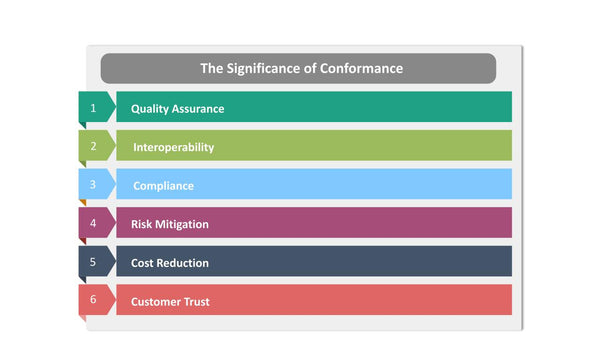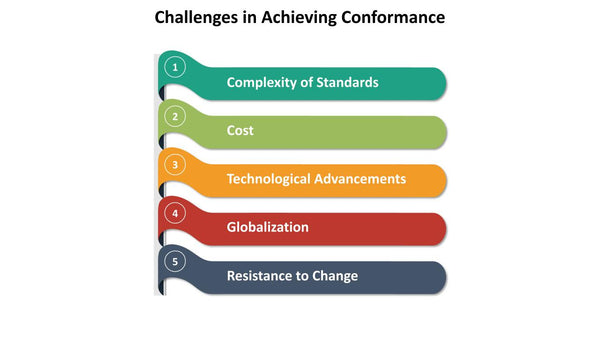Understanding Conformance: A Comprehensive Exploration
In today's rapidly evolving world, conformance plays a pivotal role in ensuring quality, consistency, and compliance across various industries and sectors. Whether it's manufacturing, healthcare, software development, or any other field, conformance is a critical concept that impacts both product and process quality. In this blog post, we will delve deep into the definition of conformance, its significance, and its applications across different domains.
Defining Conformance
Conformance, in essence, signifies the extent to which a product, process, or system aligns with predefined standards, specifications, or requirements. It serves as a yardstick for measuring how closely something matches established criteria. This concept of conformance applies across a wide spectrum, encompassing aspects such as design, functionality, performance, and safety.
It is pivotal in maintaining quality, consistency, and compliance in various industries, from manufacturing and healthcare to software development and environmental regulations. Achieving conformance is instrumental in ensuring product reliability, reducing risks, and fostering trust among consumers, regulatory bodies, and stakeholders. As organizations strive for excellence and compliance, understanding and prioritizing conformance becomes indispensable in the pursuit of success and sustainability.

The Significance of Conformance
Conformance is crucial for several reasons, each of which contributes to its overall significance:
- Quality Assurance: Conformance ensures that products and processes meet established quality standards. This is essential for delivering reliable and consistent results, reducing defects, and enhancing customer satisfaction.
- Interoperability: In the world of technology, conformance ensures that different systems and devices can work together seamlessly. It plays a critical role in enabling compatibility and integration, fostering innovation and efficiency.
- Compliance: Many industries are subject to regulatory requirements and standards to ensure safety, environmental responsibility, and ethical practices. Conformance is key to complying with these regulations and avoiding legal and financial consequences.
- Risk Mitigation: Non-conformance can lead to costly errors, accidents, and failures. By adhering to established standards, organizations can mitigate risks associated with product recalls, accidents, and legal liabilities.
- Cost Reduction: Conforming to industry standards often results in increased efficiency and reduced operational costs. It minimizes the need for costly rework, warranty claims, and customer complaints.
- Customer Trust: Consumers trust products and services that meet recognized standards. Conformance helps build trust by assuring customers that they are getting a product or service that meets established quality and safety criteria.
Applications of Conformance
Conformance finds applications in a wide range of industries and sectors. Let's explore some of the most prominent ones:
- Manufacturing: In manufacturing, conformance ensures that products meet specifications and quality standards. It is critical for product consistency, safety, and regulatory compliance. Quality control processes, such as Six Sigma and Total Quality Management (TQM), are often used to achieve conformance.
- Healthcare: Conformance is vital in healthcare to ensure patient safety and quality of care. Medical devices, pharmaceuticals, and healthcare facilities must adhere to strict regulations and standards to guarantee conformance.
- Software Development: In the software industry, conformance is essential for compatibility and interoperability. Developers need to adhere to coding standards, protocols, and data formats to ensure their software can work seamlessly with other systems.
- Environmental Compliance: Industries dealing with environmental concerns, such as energy, waste management, and pollution control, must conform to environmental regulations to minimize their ecological footprint and avoid penalties.
- Automotive: The automotive industry relies heavily on conformance to guarantee vehicle safety, performance, and emissions control. Various international standards and regulations govern vehicle manufacturing and design.
- Aerospace: The aerospace sector places a strong emphasis on conformance to ensure the safety and reliability of aircraft and spacecraft. Stringent regulations and quality control processes are in place to achieve this.

Challenges in Achieving Conformance
While conformance is essential, it can be challenging to achieve in practice. Some of the common challenges include:
- Complexity of Standards: Standards and regulations can be complex and subject to frequent updates. Staying compliant requires ongoing monitoring and adaptation.
- Cost: Ensuring conformance can be expensive, particularly for small businesses. The costs associated with testing, certification, and quality control can be a barrier to entry.
- Technological Advancements: As technology evolves, staying in conformance with emerging standards can be a challenge. This is particularly true in industries like IT and telecommunications.
- Globalization: Companies operating internationally must navigate different sets of standards and regulations in various regions, adding complexity to achieving conformance.
- Resistance to Change: Implementing new processes and systems to achieve conformance can face resistance from employees and management who may be resistant to change.
Tools and Strategies for Achieving Conformance
To overcome these challenges and achieve conformance, organizations can employ various tools and strategies:
- Quality Management Systems (QMS): Implementing a QMS, such as ISO 9001, helps organizations establish processes and procedures to consistently deliver conforming products and services.
- Testing and Inspection: Rigorous testing and inspection processes are essential for verifying conformance. This includes both in-house testing and third-party certification.
- Continuous Improvement: Embracing a culture of continuous improvement allows organizations to adapt to changing standards and identify areas for enhancement.
- Automation: Utilizing automation in manufacturing and testing processes can improve efficiency and accuracy, reducing the risk of non-conformance.
- Training and Education: Properly trained employees are more likely to understand and adhere to standards, contributing to overall conformance.
- Data Analytics: Leveraging data analytics can help organizations identify patterns and trends that may lead to non-conformance, allowing for proactive intervention.
Conclusion
Conformance is a fundamental concept that affects the quality, safety, and compliance of products and processes across a multitude of industries. Its significance lies in its ability to ensure consistency, reduce risk, and build trust with customers and regulatory bodies. While achieving conformance can be challenging, organizations that prioritize it and employ the right tools and strategies can reap the benefits of enhanced quality, improved efficiency, and a competitive edge in their respective industries. In an ever-changing world, understanding and embracing conformance is essential for success and sustainability. By recognizing its value and committing to its achievement, businesses and industries can thrive and adapt to the evolving landscape of standards and regulations.

